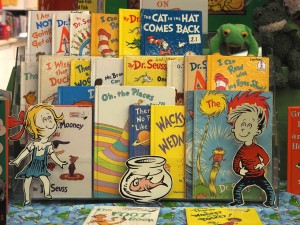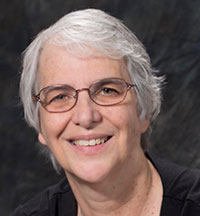School Leadership 2.0
A Network Connecting School Leaders From Around The Globe
Study says reading aloud to children, more than talking, builds literacy By Susan Frey
Study says reading aloud to children, more than talking, builds literacy
Jul 8, 2015 | By Susan Frey
- Ed Source

CREDIT: LILLIAN MONGEAU/EDSOURCE TODAY
Uriel Torres, 4, counts the windows on a building pictured in the Clifford book he’s reading with his tutor, Lisa Hern, at his home in East Palo Alto.
In “The Pout-Pout Fish” children’s picture book, the author weaves words like “aghast” and “grimace” into a story about a fish who thought he was destined to “spread the dreary-wearies all over the place” until…well, no need to spoil the ending.
Finding such rich language in a picture book is not unusual, and reading those stories aloud will introduce children to an extensive vocabulary, according to new researchconducted by Dominic Massaro, a professor emeritus in psychology at the University of California, Santa Cruz. He said although parents can build their children’s vocabularies by talking to them, reading to them is more effective.
Reading aloud is the best way to help children develop word mastery and grammatical understanding, which form the basis for learning how to read, said Massaro, who studies language acquisition and literacy. He found that picture books are two to three times as likely as parent-child conversations to include a word that isn’t among the 5,000 most common English words.
Picture books even include more uncommon words than conversations among adults, he said.
“We talk with a lazy tongue,” Massaro said. “We tend to point at something or use a pronoun and the context tells you what it is. We talk at a basic level.”

LIV AMES FOR EDSOURCE
Books by Dr. Seuss are popular with children.
Massaro said the limited vocabulary in ordinary, informal speech means what has been dubbed “the talking cure” – encouraging parents to talk more to their children to increase their vocabularies – has its drawbacks. Reading picture books to children would not only expose them to more words, he said, but it also would have a leveling effect for families with less education and a more limited vocabulary.
“Given the fact that word mastery in adulthood is correlated with early acquisition of words, shared picture book reading offers a potentially powerful strategy to prepare children for competent literacy skills,” Massaro said in the study.
The emphasis on talking more to children to increase their vocabularies is based on research by Betty Hart and Todd Risley at the University of Kansas. They found that parents on welfare spoke about 620 words to their children in an average hour compared with 2,150 words an hour spoken by parents with professional jobs. By age 3, the children with professional parents had heard 30 million more words than the children whose parents were on welfare. Hart and Risley concluded that the more parents talked to their children, the faster the children’s vocabularies grew and the higher the children’s I.Q. test scores were at age 3 and later. Since their research was published, there has been a push to encourage low-income parents to talk more to their children as a way to improve literacy.
“Reading takes you beyond the easy way to communicate,” said Dominic Massaro, psychology professor at the University of California, Santa Cruz. “It takes you to another world and challenges you.”
But more picture book reading would be beneficial to children from every social class, Massaro said. What limits the tongue of even well-educated adults are “certain rules of discourse,” such as responding quickly, he said. That reduces word choices to those acquired early and used more frequently. In conversation, people also repeat words that have been recently spoken, further restricting the variety of words used.
Writing, on the other hand, is more formal, Massaro said, even in children’s books.
“Reading takes you beyond the easy way to communicate,” he said. “It takes you to another world and challenges you.”
Reading picture books to babies and toddlers is important, he said, because the earlier children acquire language, the more likely they are to master it.
“You are stretching them in vocabulary and grammar at an early age,” Massaro said. “You are preparing them to be expert language users, and indirectly you are going to facilitate their learning to read.”
GOING DEEPER
“Two Different Communication Genres and Implications for Vocabulary... by Dominic W. Massaro, Department of Psychology, University of California, Santa Cruz, 2015
“The Early Catastrophe: The 30 Million Word Gap by Age 3” by Betty Hart and Todd Risley, University of Kansas, 1995
“The Talking Cure” by Margaret Talbot, The New Yorker, Jan. 12, 2005
Massaro said encouraging older children to sound out words and explaining what a word means if it isn’t clear in the context of the story will help build children’s vocabularies. Allowing children to pick the books they are interested in and turn the pages themselves keeps them active and engaged in learning, he said.
Reading to children also teaches them to listen, and “good listeners are going to be good readers,” Massaro said.
Massaro said that 95 percent of the time when adults are reading to children, the children are looking at the pictures, partly because picture books tend to have small or fancy fonts that are hard to read. If picture book publishers would use larger and simpler fonts, then children would be more likely to also focus on the words, helping them to become independent readers, he said.
In the study, Massaro compared the words in 112 popular picture books to adult-to-child conversations and adult-to-adult conversations. The picture books, which were recommended by librarians and chosen by him, included such favorites as “Goodnight Moon” and “If You Give a Mouse a Cookie.”
Most of the books Massaro used were fiction, but children’s picture books can also be nonfiction and discuss topics such as earthquakes or ocean life that would likely include a larger number of uncommon words, he said, giving them an even greater advantage over conversation.
To analyze the conversations, Massaro used two databases of words. One database involved 64 conversations with 32 mothers. The mothers had one conversation with their baby, age 2 to 5 months, while interacting with toys, and another “casual conversation” with an adult experimenter. The second database consisted of more than 2.5 million words spoken by parents, caregivers and experimenters in the presence of children with a mean age of 36 months.
In his comparison, Massaro identified the number of uncommon words, and he determined that the picture books he analyzed contained more of them than the language used in conversation.
Massaro’s study has been accepted for publication in The Journal of Literacy Research.

Susan Frey covers early learning, expanded learning, foster students and adult education. Email her or Follow her on Twitter. Sign up here for a no-cost online subscription to EdSource Today for reports from the largest education reporting team in California.
Tags:
Replies to This Discussion
JOIN SL 2.0
SUBSCRIBE TO
SCHOOL LEADERSHIP 2.0
Feedspot just named School Leadership 2.0 one of the "Top 25 Educational Leadership Blogs"
"School Leadership 2.0 is the premier virtual learning community for school leaders from around the globe."
-------------------------
As has been our custom, School Leadership 2.0 donated 100% of new membership fees in the the month of May to LI Cares.
---------------------------
Our community is a subscription based paid service ($19.95/year or only $1.99 per month for a trial membership) which will provide school leaders with outstanding resources. Learn more about membership to this service by clicking one our links below.
Click HERE to subscribe as an individual.
Click HERE to learn about group membership (i.e. association, leadership teams)
__________________
CREATE AN EMPLOYER PROFILE AND GET JOB ALERTS AT
SCHOOLLEADERSHIPJOBS.COM